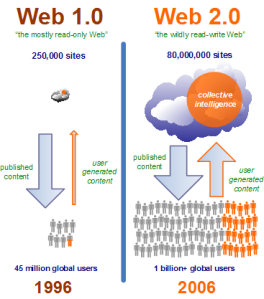To say that there is a Web 2.0 means that there was an original Web, a Web 1.0. So when did Web 1.0 leave and Web 2.0 arrive?
One could say Web 1.0 left in the early 2000s after the dot-com bubble crashed in 2001, and five years later in 2006 Web 2.0 emerged. Web 2.0 is to say that a whole new version of the of the internet was created in ’06 but rather new approaches to how we interact with the web were introduced. In his article, “What Is Web 2.0: Design Patterns and Business Models for the Next Generation of Software“, technology expert, Tim O’Reilly, explains how Web 2.0 can essentially be winnowed down to seven core concepts:
1. Web as a platform
2. Lightweight Programming Models
3. Harnessing collective Intel
4. Data is the Next Intel Inside
5. End of the Software Release Cycle
6. Software Above Level of a Single Device
7. Rich User Experience
Web as a platform
In general, the transitions from Web 1.0 to Web 2.0 metaphorically opened the floodgates to allow for more creativity for developers and higher levels of usability for both businesses and consumers. The web essentially lowers the barrier to entry of entry into certain markets. For example, the website eBay represents a how the openness of the web creates new market segments for service providers. eBay started as a website people to get resale their old stuff, like a virtual garage sale. Instead of trying to centralize data, this business model is centered around creating intermediary spaces for users and the success of the business relies on enough people using the platform.
Lightweight Programming Models
In a sense, players in Web 2.0 are saying that there is no need to reinvent the wheel. Web 2.0 allows for more re-use among web services and data. O’Reilly used Google Maps as an example of how their data was constructed in such a way that allowed for hacking; so now we can go on say Patagonia’s company website and still see Google Maps.
This remixability characteristic can also be applied to business models. Using eBay as an example again, their business model set the pace for later contenders like Etsy, Poshmark, Bonanza, Cargoh which all share similar business strategies to provide a channel for people to sell their goods. Etsy essentially refined the what eBay was already doing and tailored the experience specifically for artisans to have their own e-commerce interface.
Harnessing Collective Intel
This concept of Web 2.0 loosely mimics information flow in the scientific community where there is constant collaboration and people build off of past data. Wikipedia is an excellent example. The online encyclopedia is based off web users adding their knowledge to build their encyclopedia entries. Over time entries become more detailed as more people contribute. The search engine giant, Google, also achieved their claim to fame from their search algorithm that ranks the relevance of search results based on how popular the webpage is among users that have searched similar things. In both examples, the final products of the are the manifestation of this data collected from numerous users
Data is the Next Intel Inside
Harvesting and creating databases from web users’ activity is Maybe one of the most prominent concepts to come out of Web 2.0. Database management has now become a strategic element for companies in a number of different industries. Companies want to better connect with customers, so they rely on the data collected from individuals’ internet activity and from that activity they extrapolate trends and build customer profiles and adjust their marketing, sales and supply chain management accordingly. This fascination with user data has also lead to a rise in analysts’ positions with the corporate structure because someone has to sort through said data and create the algorithms to formulate the appropriate profile.
However, as much as companies see data collection as an advantage to user experience, this fascination with user data has opened a Pandora’s box of issues regarding big businesses and user privacy and even issues within the justice system.
End of the Software Release Cycle
Companies began to reevaluate their business strategy and change their models from providing goods to providing services. Rather than releasing new software packages every month for purchase, products became “perpetual betas”, meaning that companies began to continuously update the software on a regular basis to improve the user experience.
Here recently, companies have appeared to have hybridized of the perpetual beta and the software release model. Instead of bundling software for release, companies, such as Abode and Microsoft, are making customers buy monthly or annual subscriptions that then allow them unlimited access to the latest versions of their services.
Software Above Level of a Single Device
This streamlining access to applications across devices has only grown, even more so with the rise of smartphones. This concepts forerunner to the cloud computing systems we have today, essentially paving the way for websites like Dropbox, Box, Google Drive, and Apple iCloud.
Rich User Experience
Largely, most of the core concepts of Web 2.0 try to enrich user experience. Compared to Web 1.0, Web 2.0 heavily relies on user interaction.

User-generated content increased from when the internet was created in 1996 to the Web 2.0 era in 2006, and the numbers have only grown over time as more people have access to computers and smartphones. Web 2.0 began to see that user are just as integral to the Web as HTML code or JavaScript. Even today in 2018, companies, whether they are well established like Google or start-ups, see enhancing the user experience as a core principle that is imperative to the vitality of the business.
